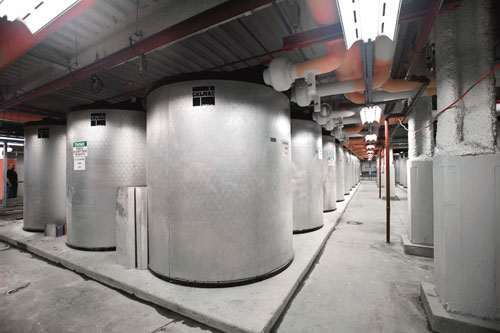Chill Factor
 |
The iconic Bank of America building at One Bryant Park relies on thermal-energy storage for about one-quarter of its cooling. Photo: David Sundberg/Esto |
There are a number of different types of ice-based TES systems in use today. The most common for buildings (as opposed to district-cooling systems) is "internal-melt ice-on-coil." Ice is made by circulating a working fluid (a glycol-water solution) cooled by a chiller through tubing embedded in water tanks. This occurs at night using off-peak electricity. During the day, the glycol solution is circulated through the ice tank and chilled by the ice. As the working fluid is chilled during the day, it melts the ice from the inner surface outward. Either the chilled working fluid is used directly for cooling, or that glycol-water solution passes through a heat exchanger to transfer cooling energy to water that is circulated through the building.
Internal-melt TES systems can be very large with single tanks, such as systems produced by Baltimore Aircoil and Evapco; others are fairly small and modular, such as systems produced by CALMAC Manufacturing and FAFCO. Ice Energy makes such a system adapted to packaged air-conditioning systems.
The benefits of using off-peak electricity
TES shifts electricity use from daytime hours, when most cooling loads occur, to nighttime, when electricity demand is lower and costs are usually less. Most utility companies offer time-of-use pricing for commercial and industrial customers; some also offer this pricing for residential customers. The discounts in off-peak electricity pricing vary widely, according to Doug Reindl, a professor of mechanical engineering at the University of Wisconsin and director of the HVAC&R Center (previously the Thermal Storage Applica-tions Research Center), but are often 30 to 50 percent and can be even greater.
As the utility industry modernizes, the ability of building owners to manage loads internally will become increasingly important-and TES provides an excellent means of doing so. With real-time electricity pricing, for example, the price per kWh can be dramatically higher during certain times of day-offering a strong incentive for a company to manage loads more precisely. Utility contracts for dispatchable or interruptible loads can provide very attractive discounts for companies if they are willing to disconnect chiller loads during peak periods and shift cooling to stored ice.
 |
Each of the 44 tanks in the building contains 1,600 gallons of water and roughly three miles of plastic tubing through which a glycol solution is circulated to create and then melt ice. Photo: Gunther Intelmann Photography |
Â
TES reduces demand charges
Most commercial and industrial utility customers pay demand charges in addition to paying for actual consumption of electricity. Demand charges are based on the peak electrical demand of a building-reasoning that the utility company has to have that amount of capacity available to the building. Typical demand charges are $10−15/kW of peak demand for commercial customers, according to Reindl. In some places though, demand charges can be a lot higher; in New York City they are as high as $36/kW during peak summer cooling periods.
It is typical for demand charges to account for about half of a company's monthly electric bill, according to Paul Torcellini of the National Renewable Energy Laboratory. However, in some cases the demand charges can significantly exceed the direct electricity consumption charges. Usually, demand charges are only levied on commercial and industrial customers, though residential customers with very high electricity usage may also have to pay these charges.
In nearly all commercial buildings, peak demand occurs during the daytime hours, when lighting, office equipment, and cooling loads are the greatest. Shifting some of the cooling load from daytime to nighttime hours with TES will reduce the peak electric demand and thus lower demand charges (see figure). The cooling can be shifted almost entirely to off-peak hours (full-storage operation), or just a portion of the load can be shifted to off-peak hours (partial storage). In either case, there will be a significant reduction in demand charges.









